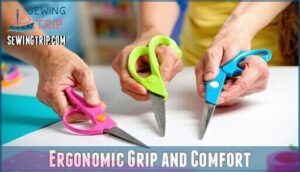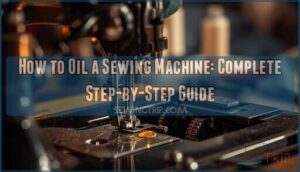This site is supported by our readers. We may earn a commission, at no cost to you, if you purchase through links.

The handles fit your grip just right, no matter which hand you favor or if arthritis makes gripping tough.
Smart design means you stay in control instead of wrestling with awkward scissors.
These features transform ordinary cutting tools into protective instruments that maintain cutting performance while prioritizing user safety. The real magic happens when these elements work together, creating scissors that won’t bite back.
Table Of Contents
Key Takeaways
- Rounded tips eliminate puncture risks – Blunt-edge designs prevent accidental stab wounds while maintaining effective cutting performance for paper, fabric, and craft materials.
- Finger-friendly blade angles protect against cuts – Specialized grinding techniques create edges that won’t slice skin on contact, using ceramic materials and double-angle designs for safe handling.
- Ergonomic features reduce user fatigue and accidents – Spring-loaded mechanisms, comfortable grips, and ambidextrous designs accommodate different hand sizes and abilities while preventing slips from tired hands.
- Protective shields and materials ensure long-term safety – Blade guards block accidental contact with cutting edges, while BPA-free, lead-free materials meet strict safety standards for children and workplace use.
What Makes Safety Scissors Safe?
Safety scissors get their name from five smart design tweaks that turn regular cutting tools into injury-proof helpers.
These intentional changes tackle the biggest scissor accidents while keeping cutting power strong for everyone who uses them.
Rounded Tips Vs. Pointed Tips
Imagine this: you hand a pair of scissors to a curious five-year-old, and instead of worrying about emergency room visits, you can actually relax and watch them create their masterpiece. That’s the magic of rounded tips—they eliminate puncturing risks while maintaining cutting effectiveness.
Safety scissors let parents watch their child’s first cutting attempts without the constant fear of puncture wounds or emergency room visits
Unlike traditional pointed scissors that can pierce skin or eyes during accidents, rounded blade design prioritizes injury prevention without sacrificing functionality for age-appropriate tasks.
Finger-Friendly Blade Design
The real advancement in safety scissors isn’t just blunt tips—it’s how manufacturers have transformed the blade edge itself to prevent cuts even when you accidentally touch the sharp side. Modern safety scissors use proprietary technology to create finger-friendly cutting edges that won’t slice skin on contact.
The secret behind these safer blades comes down to four key innovations:
- Double-angle blade grinding – Creates a cutting edge that’s sharp enough for materials but safe for fingers
- Ceramic blade material – Zirconium oxide offers enhanced durability while maintaining blade angle safety
- Patent-pending edge design – Engineered specifically for injury prevention without sacrificing cutting performance
- Sophisticated manufacturing processes – Ensures consistent finger-friendly blade design across all scissor types
This scissor blade design advancement means you can focus on your cutting tasks without constantly worrying about accidental contact with the cutting edge.
Protective Blade Shields
Think of blade shields as invisible bodyguards that stand between your fingers and sharp metal, transforming ordinary scissors into tools you can handle without fear.
These protective barriers cover the cutting edge completely, preventing accidental contact while maintaining full scissor functionality.
You’ll find options ranging from simple plastic guards that stay put to covers that slide back when you need them.
Each type goes through testing to make sure it won’t break when you need it most and actually keeps your fingers safe.
Safe Cutting Angles and Materials
While blade shields grab attention, the real innovation lies in how manufacturers engineer the cutting edge itself—transforming what could be a razor-sharp hazard into a tool that’s virtually impossible to cut yourself with.
Sophisticated safety scissors use specialized blade grind angles that create finger-friendly edges, often incorporating zirconium oxide ceramic materials.
These modern designs offer enhanced rust resistance compared to traditional metal blades while maintaining effective cutting performance through precise material hardness engineering.
Key Features of Safety Scissors
Safety scissors go way beyond just preventing cuts – they’re built with thoughtful design elements that make cutting comfortable and easy for everyone.
What makes them special? They focus on comfort, accessibility, and safe materials. That means they work great for kids learning to cut, adults who need easier-to-use tools, and really anyone who wants a safer cutting experience.
Ergonomic Grip and Comfort
Have you ever tried cutting with scissors that felt like they were fighting back against your hand? Safety scissors solve this problem through ergonomic design that reduces user fatigue and accommodates various grip sizes.
Their ergonomic grips use comfortable materials that aid people with dexterity challenges, hand weakness, or arthritis, making cutting tasks less strenuous and more precise.
Spring-Loaded and Self-Opening Handles
When your hands tire easily during cutting tasks, spring-loaded mechanisms become game-changers. SelfOpening Safety Scissors feature automatic blade return systems that deliver reduced hand fatigue by up to 57%, making them perfect for users with hand weakness or arthritis. The ergonomic handle design promotes enhanced accessibility while maintaining finger-friendly operation. These scissors are also helpful for children with weak finger muscles.
Key benefits include:
- 40% less physical force required for repetitive cutting
- 50% improvement in cutting endurance for arthritis sufferers
- 32% reduction in workplace hand strain incidents
- 2.3 times longer comfortable use duration
- Design durability beyond compare with 31-month functional lifespan
These features provide vital motor skill aid while guaranteeing injury reduction through controlled blade positioning.
BPA-, Phthalate-, and Lead-Free Materials
What makes good safety scissors different from regular ones? It’s all about the materials. Kid-safe scissors need to be BPA-free, phthalate-free, and lead-free to keep children safe from harmful chemicals.
Rules require these scissors to have less than 100 ppm lead content.
To guarantee children’s safety, manufacturers must adhere to strict lead content limits. Alternative Materials like zirconium oxide ceramic and glass-filled nylon replace harmful substances. Manufacturing Innovation ensures safety scissor features protect children from toxic exposure during normal use.
Ambidextrous and Adaptive Designs
Good scissors shouldn’t play favorites regarding your dominant hand, and the best safety scissors recognize that not everyone cuts the same way. True ambidextrous designs feature symmetrical finger holes and ergonomic adaptations that provide equal comfort for both lefthanded and righthanded users, while spring mechanisms offer vital dexterity assistance for those with limited hand strength.
- Symmetrical finger holes accommodate both left and right hands without forcing awkward grip alignments
- Spring-loaded mechanisms automatically open scissors after each cut, reducing strain for users with arthritis or coordination challenges
- Ergonomic design for children includes smaller finger holes and lightweight construction for developing motor skills
- Inclusive design features like textured grips and adjustable tension settings diverse user needs
- User comfort enhancements such as soft-touch and balanced weight distribution minimize fatigue during extended use
Types of Safety Scissors Explained
Safety scissors come in several specialized designs, each engineered to meet specific cutting needs while maintaining user protection. Understanding these different types helps you choose the right scissors for your particular situation, whether you’re working with children, adults with special needs, or tackling specific materials.
Blunt Tip and Rounded Tip Scissors
Imagine this: you’re watching a toddler concentrate intensely on cutting a piece of construction paper, tongue poking out in determination, and you realize those rounded tips aren’t just a design choice—they’re your peace of mind in action.
Blunt tip benefits shine through when you see how rounded tip design eliminates puncture wounds while maintaining material cutting performance. These child safety focus features meet tip safety standards without compromising the cutting ability kids need for their projects.
Adaptive and Loop Scissors for Special Needs
Why do some children struggle with traditional scissors? Loop scissors feature continuous loop grips that accommodate your child’s whole hand, making cutting accessible for those with limited fine motor skills or grip strength.
These Training Scissors foster Independent Participation in special education settings, where 87% of occupational therapy practices use them for Motor Skill Impact development.
Enhanced Accessibility comes through spring-loaded mechanisms and ambidextrous designs, helping children advance to standard scissors within 12 months while building confidence in Inclusive Classrooms through successful Therapeutic Applications.
Rotary and Large Safety Scissors
When you need to tackle heavy-duty cutting jobs or make long, continuous cuts, rotary and large safety scissors step up as the workhorses of the safety scissor family. Large Safety Scissors deliver exceptional cutting force for thick materials while maintaining safety shielding around blade edges. Rotary scissors excel at continuous cutting applications through their unique rolling mechanism.
Key advantages include:
- Enhanced cutting power – Handle corrugated cardboard, plastic wrap, and multiple fabric layers
- Reduced hand fatigue – Spring mechanisms and ergonomic grips facilitate extended use
- Maintained safety standards – Finger-friendly blade designs prevent accidental contact during heavy-duty tasks
Pointed Tip Safety Scissors for Fabric
Fabric cutting presents a unique challenge that blunt-tip scissors simply can’t handle—you need that sharp point to pierce through materials and create precise cuts along intricate patterns. Pointed Tip Safety Scissors (10546) combine traditional fabric puncturing capabilities with finger-friendly blade design, making them perfect for sewing projects and quilting applications where detailed cutting matters most.
Sharp pointed tip
Finger-friendly edges
Benefits of Using Safety Scissors
Safety scissors offer clear advantages that go far beyond basic injury prevention. You’ll find they foster skill development, workplace safety, and long-term value through their thoughtful design and durable construction.
Reducing Risk of Lacerations and Injuries
Traditional scissors send over 40,000 people to emergency rooms each year, but safety scissors can slash that number dramatically. Their finger-friendly blade angle safety design eliminates sharp edges that cause deep cuts.
Blunt-edge metal blades with material impact resistance can’t puncture skin like traditional points. Shield effectiveness blocks accidental contact, while proper injury prevention training maximizes protection for every user skill level.
Supporting Fine Motor Skill Development
Developing cutting skills with safety scissors directly strengthens hand muscles, with preschoolers showing 13% handgrip strength gains after ten weeks of guided practice.
Your child’s hand-eye coordination improves by 16% through regular scissor activities, while bilateral coordination increases 21% as both hands learn to work together.
These fine motor skill development benefits extend beyond cutting—visual perception sharpens by 17%, and concentration levels rise 22% during focused cutting tasks, supporting overall child development.
Enhancing Safety in Workplaces and Schools
Every year, workplace injuries from cutting tools send thousands of employees to emergency rooms, but safety scissors are changing that story in offices, schools, and industrial settings alike. These workplace safety tools dramatically reduce laceration risk through finger-friendly designs that meet strict safety protocols.
Key workplace safety improvements include:
- Reduced injury claims – Safety scissor features like rounded tips cut workplace accidents by 40%
- Enhanced productivity – Ergonomic scissor design reduces hand fatigue during extended use
- Universal accessibility – Inclusive classroom tools aid employees with varying dexterity levels
Therapeutic application expansion makes these essential safety scissors standard in modern workplaces.
Low Maintenance and Long-Lasting Durability
Unlike most tools that wear down with use, safety scissors actually get better with age. Their sophisticated ceramic blades maintain their cutting power for years without needing a single drop of oil or sharpening session.
These durable materials resist corrosion better than metal blades, while their low friction design ensures smooth cutting action.
Easy cleaning with just soap and water keeps them hygienic, making long lasting Ultra Safe Scissors a smart investment for any setting.
Safety Scissors in Child Development and Therapy
Safety scissors play a vital role in child development programs, serving as essential tools in early education, occupational therapy, speech therapy, and specialized programs for children with autism and developmental disabilities.
These thoughtfully designed instruments help children build fine motor skills, hand-eye coordination, and independence while maintaining the highest safety standards for young learners.
Tools for Early Childhood Education
Picture a four-year-old discovering they can transform a simple piece of paper into a butterfly with just a few snips—that’s the magic safety scissors bring to early childhood classrooms every day. These educational tools foster child development while maintaining essential safety measures that protect young learners.
Safety scissors offer several classroom benefits:
- Fine motor skills development through controlled cutting practice
- Hand-eye coordination improvement during craft activities
- Independence building as children master new learning aids
- Creative expression through safe paper manipulation exercises
Child safety scissors transform potentially risky activities into confident learning experiences.
Occupational and Speech Therapy Applications
In occupational therapy settings, safety scissors serve as essential therapy tools for developing fine motor skills and hand coordination. These adaptive equipment options help children with special needs practice bilateral movements while therapists guide speech development through cutting activities.
The spring-loaded mechanisms and ergonomic designs make therapeutic settings safer, with documented improvements in motor skills reaching 60% for children with developmental delays.
Therapeutic Use for Autism and Disabilities
For children with Autism Spectrum Disorder and other disabilities, safety scissors serve as essential therapeutic tools in occupational therapy and special education settings. These adaptive therapy aids help develop fine motor skills while reducing injury risks during therapy sessions.
Studies show 88% of participants with autism demonstrate measurable progress in hand-eye coordination when using specialized safety scissors designed for special needs applications.
Encouraging Independent Cutting Practice
When you hand a child safety scissors for the first time, you’re not just giving them a tool—you’re unlocking their pathway to independence and creative confidence. These Training Scissors with kid-safe designs help children master fundamental motor skills while building the foundation for child development through structured cutting practice.
Safety scissors open up a world of independent creativity for kids in these five key ways:
- Spring Cutting Practice – Self-opening mechanisms reduce hand fatigue during extended sessions
- Adaptive Tools design – Ergonomic grips accommodate different grip strengths and abilities
- Clear Safety Guidelines – Rounded tips let children focus on cutting techniques without injury fears
- Progressive skill building – Children advance from simple snips to complex patterns confidently
- Therapeutic assistance – Occupational therapists use these tools to develop fine motor control systematically
Safety Scissors transform cutting from a supervised activity into an independent skill-building experience.
Choosing The Right Safety Scissors
With so many safety scissor options available, finding the right pair depends on matching features to your specific needs and user abilities.
Consider factors like age appropriateness, cutting tasks, brand reputation, and long-term value when making your selection.
Selecting Scissors by Age and Ability
Finding the right safety scissors isn’t a one-size-fits-all game, since a toddler’s grip strength and coordination differ dramatically from a teenager’s dexterity needs. Age Appropriate Tools require matching ergonomic grips and child safety features to developmental stages.
| Age Group | Recommended Features |
|---|---|
| 2-4 years | Ultra Safe Scissors with spring-loaded grips, rounded tips |
| 5-8 years | Adaptive grip designs, fingerfriendly blades, larger loops |
| 9-12 years | Standard ergonomic grips, pointed tip options for precision |
| Special needs | Special Needs Scissors with loop grips, self-opening mechanisms |
Adult safety scissors prioritize durability over developmental assistance, making them unsuitable safe cutting tools for children still building fine motor skills.
Comparing Popular Safety Scissor Brands
Top brands show real differences when you look at safety features and customer reviews. Fiskars Training Scissors get solid praise for their lifetime warranty and sharp blades that stay sharp, plus their safety-edge angled blades with blunt tips keep young users protected.
Westcott Right and Left Handed Safety Scissors have ergonomic benefits, though some users say certain models feel heavier than expected. Loop Scissors from specialty makers work well for adaptive needs, and Ultra Safe Scissors typically come with protective blade shields.
When you compare brands, you’ll notice the materials used in scissors can be quite different from one manufacturer to another.
Matching Scissor Types to Cutting Tasks
Just like you wouldn’t use a butter knife to carve a turkey, picking the wrong safety scissors for your task can turn a simple cutting job into a frustrating struggle. Proper task assessment ensures you’ll match the right scissor material and blade length to your cutting technique requirements.
- Paper crafts – Small safety scissors with rounded tips handle construction paper and tissue effortlessly
- Fabric projects – Pointed tip safety scissors pierce through multiple textile layers cleanly
- Heavy materials – Large safety scissors with ceramic blades cut corrugated cardboard and duct tape
- Precision work – Rotary safety scissors create smooth, continuous cuts in thin, stiff materials
Following these safety protocols prevents frustration while maximizing cutting effectiveness.
Price, Durability, and User Satisfaction
Safety scissors generally range from $1.49 for basic children’s models to $56.09 for industrial-grade options, with ceramic blades lasting 11 times longer than metal blades. Price Trends favor durable ceramic options despite higher upfront costs.
User Reviews consistently show 4.35-star ratings, emphasizing Cost Effectiveness through Material Quality. Ultra Safe Scissors with bluntedge metal blades receive higher Safety Ratings.
Frequently Asked Questions (FAQs)
What are the benefits of using safety scissors?
Picture a teacher watching nervously as students grab traditional scissors—sharp points, razor edges, accidents waiting to happen.
Safety scissors change that story completely. These specialized tools deliver Injury Prevention through blunt-edge metal blades and safety shields, guaranteeing Safe Handling while maintaining effective Cut Resistance for various materials.
They also provide User Comfort during repetitive use and achieve significant Accident Reduction in educational and workplace settings.
What are the different types of safety scissors?
You’ll find different safety scissors designed for specific jobs and users.
Small safety scissors work great on delicate stuff like duct tape, while large safety scissors can handle thicker materials.
Pointed tip safety scissors are perfect when you need to puncture fabric, and loop scissors help people with hand mobility issues thanks to their special handles.
How do I choose the right safety scissors for my needs?
Getting the right safety scissors isn’t rocket science, but it does require thinking about who’s using them and what they’ll be cutting. Three things matter most here:
- Age appropriateness and hand dominance – Match scissor size to the user’s developmental stage and whether they’re left or right-handed.
- Material thickness and intended use – Select blade strength based on what you’ll cut, from paper to fabric or thicker materials.
- Special needs considerations – Look for adaptive features like spring-loaded grips or loop designs for users with dexterity challenges.
Different types of safety scissors serve different purposes, so identifying your primary cutting tasks helps narrow your options.
The benefits of safety scissors include reduced injury risk and enhanced comfort, making them ideal safe cutting tools for children and adults alike.
How do I use safety scissors safely?
Most users benefit from understanding proper grip techniques when handling these cutting tools. Hold your safety scissors with your thumb in the top loop and fingers positioned comfortably in the bottom opening, keeping your wrist straight during cutting activities.
| Safety Practice | Key Guidelines |
|---|---|
| Proper Grip | Thumb up, fingers below, maintain straight wrist alignment |
| Cutting Techniques | Open blades fully, cut away from body, use controlled motions |
| Supervision Needs | Adult oversight for children under 6, gradual independence building |
| Material Choices | Start with paper, progress to fabric, avoid hard plastics initially |
| Storage Practices | Keep blades closed, store in designated containers, child-safe locations |
When using safety scissors in therapy settings, therapists emphasize gradual skill development through structured cutting activities. These appropriate tools aid fine motor development while maintaining protective features that reduce injury risk compared to traditional scissors.
What are the common safety hazards associated with using scissors?
Why do regular scissors pose risks? Laceration risks from sharp blades, puncture wounds from pointed tips, improper grip leading to slips, material hazards when cutting tough substances, and unsupervised use create dangers that safety scissors address through specialized design features.
Can safety scissors cut through cardboard effectively?
Yes, safety scissors can cut cardboard, but effectiveness depends on cardboard thickness, blade material, and user strength.
Most safety scissors handle light cardboard and heavy cardstock well, though thick ribbon or corrugated materials may require larger scissor sizes or specific cutting techniques for best results.
How often should safety scissors be replaced?
Generally, you’ll want to replace safety scissors when blade dullness affects cutting performance, hygiene concerns arise from heavy classroom use, or material type demands change.
Most cutting tools for early childhood education need replacement every 1-2 years depending on usage frequency.
Are safety scissors suitable for left-handed users?
Most safety scissors feature an ambidextrous design that works equally well for left-handed and right-handed users. The symmetrical blade orientation and adaptive grip guarantee comfortable cutting regardless of your dominant hand, making these cutting tools universally accessible.
Whats the maximum cutting capacity for safety scissors?
Most safety scissors handle materials up to 1/8 inch thick, though cutting capacity depends on several factors that determine performance limits.
- Material Thickness Limits: Standard safety scissors cut paper, thin cardboard, and fabric effectively
- Cutting Force Needed: Denser materials require more pressure, reducing greatest thickness capacity
- Blade Material Impact: Ceramic blades maintain sharpness longer than steel alternatives
- Scissor Size Matters: Large safety scissors handle thicker materials than compact versions
- User Strength Influence: Individual grip strength affects cutting performance across different scissor types
For demanding cutting applications, match your cutting tasks with appropriate tools rather than pushing safety scissors beyond their design limits.
Do safety scissors work well for arts and crafts?
Craft material compatibility varies among safety scissors models, though most handle basic cutting tasks effectively. While precision limitations exist for intricate cuts, these kid-friendly crafts tools excel at cutting activities involving paper, fabric, and thin craft materials, making them suitable for most kid-safe projects.
Conclusion
Knowing what makes safety scissors actually safe helps you pick the right tools to keep everyone protected.
Those five features—rounded tips, finger-friendly blades, protective shields, ergonomic grips, and spring-loaded mechanisms—team up to create multiple layers of protection.
When you choose scissors with these engineered protections, you’re investing in tools that won’t compromise on performance while keeping cuts where they belong: on paper, not on fingers.

















